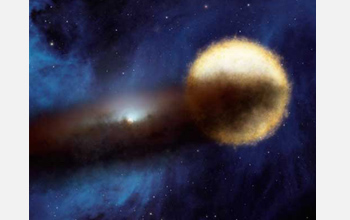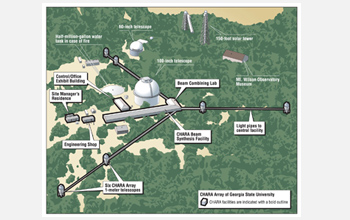All Images
News Release 10-056
Astronomers Capture a Rare Stellar Eclipse in Opening Scene of Year-long Show
Ground-based CHARA Array enables unprecedented images of a double star system some 2,000 light years from Earth
This material is available primarily for archival purposes. Telephone numbers or other contact information may be out of date; please see current contact information at media contacts.

In this artist's concept, Epsilon Aurigae (the supergiant star at right) is starting to be eclipsed by the dust disk circling a single, much dimmer B star. A new model explains the decades-old paradoxes of this system by assuming that its stars are relatively old, not young.
Every 27 years, a bright star called Epsilon Aurigae fades over period of two years, then brightens back up again. Though amateur and professional astronomers have observed the system extensively, the nature of both the bright star and the companion object that periodically eclipses it had remained unclear. The companion is known to be surrounded by a dusty disk, as illustrated in this artist's concept.
Credit: NASA / JPL-Caltech
Download the high-resolution JPG version of the image. (12 KB)
Use your mouse to right-click (Mac users may need to Ctrl-click) the link above and choose the option that will save the file or target to your computer.

A telescope making up part of the CHARA Array, a six-telescope optical/infrared interferometric array, is shown on Mount Wilson, Calif. The CHARA Array is among the most powerful facilities of its kind in the world for studying stars and stellar systems at resolutions not previously available. Built with funds from the National Science Foundation, Georgia State University, the W. M. Keck Foundation, and the David and Lucile Packard Foundation, ground was broken in 1996 at historic Mount Wilson Observatory. The facility was dedicated in 2000, and "first fringes," which demonstrated the technical feasibilty of CHARA's design, were obtained in 2001. Another three years of installation was required before the array became fully operational in 2004; routine, scheduled observing began in the spring of 2005. Collaborative teams have joined with Georgia State University scientists to extend the science capabilities of the array through "beam combination" instruments that provide for increased wavelength, spectral and polorimetric coverage.
Credit: Robert Stencel, University of Denver
Download the high-resolution JPG version of the image. (361 KB)
Use your mouse to right-click (Mac users may need to Ctrl-click) the link above and choose the option that will save the file or target to your computer.

Images of the Epsilon Aurigae: the first taken pre-eclipse in 2008, the second two were taken in November and December 2009 respectively. All images were acquired using CHARA-MIRC, the Michigan Infrared Combiner.
Credit: John Monnier, University of Michigan
Download the high-resolution JPG version of the image. (230 KB)
Use your mouse to right-click (Mac users may need to Ctrl-click) the link above and choose the option that will save the file or target to your computer.

The layout of the CHARA Array on the grounds of the Mount Wilson Observatory is shown here.
Credit: Georgia State University
Download the high-resolution JPG version of the image. (405 KB)
Use your mouse to right-click (Mac users may need to Ctrl-click) the link above and choose the option that will save the file or target to your computer.


